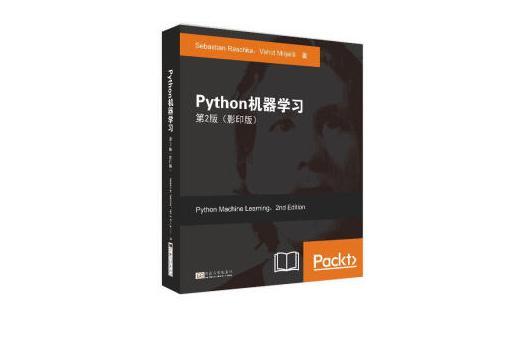《Python機器學習第2版(影印版)》是2018年東南大學出版社出版的圖書,作者是Sebastian,Raschka,Vahid,Mirjalili。
基本介紹
- 中文名:Python機器學習第2版(影印版)
- 作者:Sebastian,Raschka,Vahid,Mirjalili
- 出版社:東南大學出版社
- ISBN:9787564178666

《Python機器學習第2版(影印版)》是2018年東南大學出版社出版的圖書,作者是Sebastian,Raschka,Vahid,Mirjalili。
《Python機器學習——數據建模與分析(第2版)》是電子工業出版社出版的圖書,作者是薛薇。內容簡介 本書將引領讀者進入Python機器學習領域。機器學習是一套先進、深刻且內容豐富的算法集合,已成為數據科學中數據建模與分析的重要方法。Pyth...
《Python機器學習(原書第2版)》是機械工業出版社出版的圖書,作者是[美] 塞巴斯蒂安·拉施卡(Sebastian Raschka),[美] 瓦希德·米爾賈利利(Vahid Mirjalili)內容簡介 本書自第1版出版以來,備受廣大讀者歡迎。與同類書相比,本...
《Python機器學習經典實例第2版》是2021年人民郵電出版社出版的圖書,作者是朱塞佩·查博羅(Giuseppe Ciaburro)。內容簡介 本書介紹了如何使用scikit-learn、TensorFlow等關鍵庫來有效解決現實世界的機器學習問題。本書著重於實用的解決方案...
《Python 機器學習 : 核心技術與開發實戰 》是一半由頡騰文化策劃,北京理工大學出版社出版的圖書,作者是阿爾伯托·阿爾塔桑切斯,主要講述了入探索了人工智慧的精髓,將你引領進入這個充滿前沿科技和激動人心可能性的領域。內容簡介 《...
Python機器學習案例教程(原書第2版) 《Python機器學習案例教程(原書第2版)》是2021年機械工業出版社出版的圖書。
《Python機器學習實戰案例(第2版)》是2022年清華大學出版社出版的圖書,作者是趙衛東、董亮。 內容簡介 機器學習是人工智慧的重要技術基礎,涉及的內容十分廣泛。本書基於Python語言,實現了12個典型的實戰案例,其內容涵蓋了機器學習的基礎...
《Python機器學習》是2017年機械工業出版社出版的圖書,作者是塞巴斯蒂安·拉施卡(Sebastian Raschka)。內容簡介 本書將機器學習背後的基本理論與套用實踐聯繫起來,通過這種方式讓讀者聚焦於如何正確地提出問題、解決問題。書中講解了如何...
《Python機器學習》是2021年機械工業出版社出版的圖書。內容簡介 《Python機器學習》從實用的角度出發,整合Python語言基礎、數據分析與可視化、機器學習常用算法等知識。內容從*基本的Python編程基礎入手,由淺入深、循序漸進地講授NumPy庫和...
《Python機器學習》是清華大學出版社2020年6月出版的圖書,作者是[新加坡] 李偉夢(Wei-Meng Lee),譯者是李周芳。內容簡介 《Python機器學習》面向機器學習新手,主要內容如下:● Python機器學習的一些基本庫,包括NumPy、Pandas和...
《Python機器學習》是中國青年出版社出版的圖書,作者是日本系統規劃研究所。內容簡介 《Python機器學習》講解未來人工智慧技術中的機器學習,從入門知識到實踐。全書分為“導入篇”、“基礎篇”、“實踐篇”三部分。 導入篇包括第1章...
《Python機器學習》是2019年人民郵電出版社出版的圖書。內容簡介 《Python機器學習》通過解釋數學原理和展示編程示例對機器學習進行了系統、全面的解析。《Python機器學習》共分為12章,內容涵蓋了機器學習以及Python語言的基礎知識、特徵工程的...
《TensorFlow深度學習(第2版 影印版 英文版)》面向的是希望利用TensorFlow的強大功能,結合其他的開源Python庫構建強大、穩健、準確的預測模型的開發人員、數據分析師、機器學習從業者和深度學習愛好者。 在《TensorFlow深度學習(第2版 影...
《Python機器學習基礎》是一本2022年清華大學出版社出版的圖書,作者是唐四薪,主要講述了機器學習算法的基本原理和Python程式實現。內容簡介 本書對機器學習算法的基本原理和Python程式實現進行了系統的介紹,每種算法都採用Sklearn程式實現...
《Python機器學習:預測分析核心算法》是2018年1月人民郵電出版社出版的圖書,作者是[美]鮑爾斯 。內容簡介 在學習和研究機器學習的時候,面臨令人眼花繚亂的算法,機器學習新手往往會不知所措。本書從算法和Python 語言實現的角度,幫助...
《Python機器學習手冊:從數據預處理到深度學習》採用基於任務的方式來介紹如何在機器學習中使用Python。書中有近200個獨立的解決 方案,針對的都是數據科學家或機器學習工程師在構建模型時可能遇到的常見任務,涵蓋從簡 單的矩陣和向量運算...
《Python機器學習入門》是2021年人民郵電出版社出版的圖書,作者是程晨。內容簡介 Python是一種解釋型、面向對象、動態數據類型的高級程式設計語言。它具有豐富和強大的模組(庫),能夠很輕鬆地把用其他程式語言(尤其是C/C )編寫的...
《Python機器學習經典實例(影印版 英文版)》這本實用指南提供了近200則完整的攻略,可幫助你解決日常工作中可能遇到的機器學習難題。如果你熟悉Python以及包括pandas和scikit-learn在內的庫,那么解決一些特定問題將不在話下,比如數據載入...
《Python機器學習及實踐》是清華大學出版社2020年出版的圖書,作者是梁佩瑩。內容簡介 Python是目前比較熱門的程式語言,以簡單易學、套用廣泛、類庫強大而著稱,是實現機器學習算法的首選語言。本書以Python 3.6.5為編寫平台,以幫助讀者...
《Python機器學習基礎教程》是2020年4月人民郵電出版社出版的圖書,作者是[德]安德里亞斯·穆勒、[美]莎拉·吉多。內容簡介 本書是機器學習入門書,以Python語言介紹。主要內容包括:機器學習的基本概念及其套用;實踐中常用的機器學習算法...
《Python機器學習技術:模型關係管理》是電子工業出版社於2023年出版的書籍,作者是丁亞軍。內容簡介 本書的主體內容包括機器學習概念與特徵工程、機器學習技術、模型關係管理,其中,模型關係管理部分主要介紹了弱集成學習、強集成學習和混合...
《機器學習Python版(英文版)》是2022年機械工業出版社出版的圖書。 內容簡介 本書面向初學者,使用Python語言以及流行的scikit-learn機器學習庫等資源,通過易於實踐的項目,幫助讀者掌握開發有效的機器學習系統所需的流程、模式和策略。本...
《機器學習—Python實踐》是2018年電子工業出版社出版的圖書,作者是魏貞原。圖書簡介 圖書信息 作 譯 者:魏貞原 出版時間:2018-01 版 次:01-01 開 本:16開 印 次:01-01 I S B N :9787121331107 內容簡介 本書系統地講解...
《Python機器學習(微課視頻版)》是由2020年8月清華大學出版社出版的圖書。作品簡介 本書由淺入深、圖文並茂地介紹了Python機器學習方面的相關內容,並通過150多個實際案例,手把手地教會讀者掌握用Python語言進行機器學習相關項目開發的方法...
